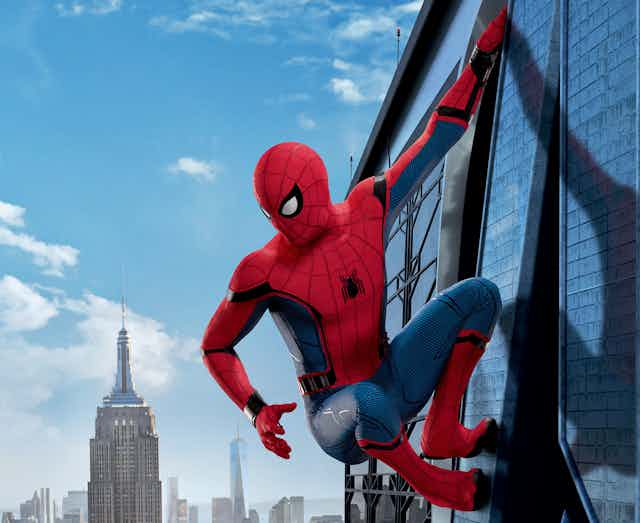“Spider-Man, Spider-Man, does whatever a spider can”
Spider-Man: Homecoming is the second modern reboot of the Spider-Man film franchise, with the young Tom Holland following in the footsteps of Tobey Maguire and Andrew Garfield. That’s three different film series in a 15-year period!
The movie takes a relative step back in scale from the universe-destroying plot elements of recent Marvel films, concentrating on a young Peter Parker’s struggle to balance school and being Spider-Man.

The film is great - a very funny, teenage-focused take on Spider-Man. It also benefits from a more human, more interesting villain than recent Marvel films, in the form of Michael Keaton who plays Vulture.
Here we’ll get stuck into some of the science behind the scenes. There are minor spoilers ahead but nothing that you couldn’t get already from the trailer, which you can check out below:
Web shooting
Spiderman moves through the city effortlessly (mostly) by shooting his web out to attach onto high points and swinging repeatedly.

If we assume that the web is itself not powered (more like an unpowered projectile; a bullet rather than a rocket), we can calculate the initial shooting velocity required to reach the tops of buildings with his shots.
First let’s try ignoring air resistance to keep things simple. We’ll need the acceleration due to gravity, g, and the height of the shot, h:
v = sqrt(2 × g × h)
= sqrt(2 × 9.81 × 100)
= 44.29m/s
= 159.5km/hr
That’s not very fast - a bullet from a .22 rifle exits the gun at a speed of about 300 m/s.
However, if air resistance was taken into account, it’s likely that the web firing speed would need to be significantly higher.
Verdict: Plausible, given the apparent speed of the web shots on screen.
Swinging off a web

Most people have heard the common sayings about spider web being “stronger than steel”, even though that’s a myth.
On screen, it looks like Spider-Man swings around on a pretty thin bundle of web. Is this realistic (assuming his web is like a normal spider’s web, not some Marvel universe “super” web)?
Spider web has a tensile strength of about 1,000 Megapascals (MPa). This means it can support 109 Newtons per square metre - 1 billion Newtons is the force required to hold a 100,000 tonne weight. The square metre refers to the cross-sectional area of the web.
Of course, he hangs off a web strand that is much thinner than 1 square metre - from the image it looks like the strand has a width of maybe 3 mm. If the strand is a cylinder, of radius r and knowing PI (𝝅) is 3.14, then we can calculate area (A):
A = 𝝅 × r2
= 𝝅 × 0.00152
= 0.000007069 m2
That means the web strand can hold a static force (W) of:
W = A × tensile strength
= 0.000007069m2 × 1,000MPa
= 7,069 Newtons
That could support a static weight of about 720 kilograms (divide by gravity = 9.81 m/s/s).
Now when spider-man jumps off a building and falls, he exerts a dynamic loading on the web, increasing his effective weight from say 60 kg by several times. Even so, carrying his own weight is plausible.
Verdict: Plausible for his own mode of personal transportation.
However, he takes on much heavier objects with his web…
Holding a ship together with web
During a fight between Vulture and Spider-Man, a malfunctioning Chitauri gun slices the Staten Island ferry in half, threatening to drown the passengers. Spider-Man intervenes with his web, endeavouring to hold the two halves of the ship together.

Spider-Man doing his best to keep everything in one piece. Columbia Pictures/Marvel Studios/Sony Pictures
Doing the calculation properly for the forces involved in holding a ship together like this would be very complex and involve modelling the interaction of the ship with the water.
We can do an approximation by ignoring any supportive force from the water, and considering the moment at which the ship is cut in half (before the two halves tilt outwards much).
A Staten Island ferry can weigh around 3,200 tonnes. Each half will feel a gravity force of 9.81 × 3,200,000 = 31,392,000N.
The ferry is 21 metres wide, so each half is 10.5 metres wide. If we assume the ferry is a homogenous mass, then each gravity force will act at a distance halfway out from the centreline: 0.5 × 10.5 = 5.25 metres out from the centreline.
Moment = 2 × F × d
= 2 × 31,392,000N × 5.25m
= 329,616,000Nm
To counteract this moment, Spider-Man positions himself between the two halves of the boat and shoots spider strands out to hold the halves together - what the steel structure was doing before it was cut in two. It’s not dissimilar to the Strongman “Hercules Hold” event:
If we assume the ferry is about as tall as it is wide, we can say that Spider-Man’s webs are pulling the boat together at about half the height above the bottom of the ship - 0.5 × 21 = 10.5m. We can calculate the two forces he would have to pull together the boat with:
Moment = 2 × F × d
= Moment / 2 / d
= 329,616,000Nm / 2 / 10.5
= 15,696,000N

A splitting headache for Spider-Man (DZIANIS RAKHUBA/123RF.COM/MICHAEL MILFORD)
The web would be under a total tensile force from these forces combined - so about 31,392,000N.
We can calculate the cross-sectional area of spiderweb required to do that:
Area = F / tensile strength
= 31,392,000N / 1,000MPa
= 0.03139 m2
And consequently the number of “normal” web shots (3mm-thick strands) he’d need to shoot:
Number of web shots = area required / web shot cross sectional area
= 0.03139m2 / 0.000007069m2
= 4,441 shots
Even though he does go crazy with the web, it still doesn’t look like he gets off anywhere near that many shots…
Verdict: It’s a nice touch that they show him targeting the strong points of the ship structure for his web reinforcement. Even with that, he was in big trouble though - so it’s pretty realistic that Ironman had to come save him and the ship.
The verdict
Spider-Man: Homecoming is great blockbuster entertainment, as fun as the Guardian of the Galaxy movies in a more family-friendly way.
It’s regularly very funny, while managing to not veer into trying too hard. Tom Holland is fantastic as Peter Parker / Spider-Man and says he will continue with the role, which is great news for fans.
In terms of the science, the film does pretty well. Within the “rules” of the MCU universe, most of the big scenes are plausible.
There’s even a nice touch in a classroom scene, when Peter is quizzed by his science teacher on the formula for angular acceleration of a pendulum.
Peter’s answer of angular acceleration = gravity * sin(theta) is both correct and also a sly reference to Spider-Man’s frequent mode of transport - swinging through the city streets on a web “pendulum”.
So - entertaining and accurate: we hope that the new Spider-Man sticks around for a while yet.


